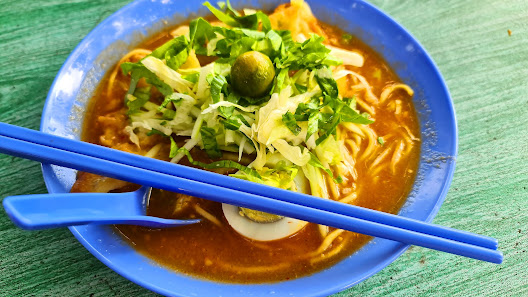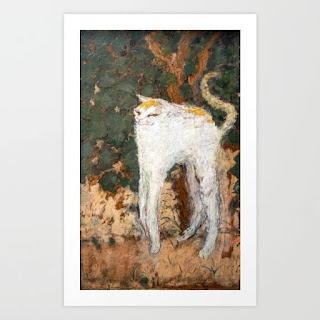Ipoh or Bust
Is 5am morning or night? It was dark outside. Does that have a bearing on that dilemma? I'm not sure.
I'd not been to Ipoh (Perak, Malaysia) since my old mate Jules had flown over to visit his father's grave in God⁶s Little Acre, Batu Gajah. That was way back in 2017. It's now 2024. Jules has since joined his father, not in Perak but in whichever haven old white lovers of Asia go to when they die.
At the start of the journey, and in my naivety, I had expected some Bogartian quip, perhaps regarding buckling up, bumpy rides and whistling, but no. This was Malaysia. Different culture.
In total, it took just over two hours and a half to transverse the Malaysian North/South Highway, then the back roads, from Kuala Lumpur to Ipoh. We’d edged alongside the undulating mountain range which dissects the Malay Archipelago (the Titiwangsa Mountains), oil palm plantations and, in-car conversations which had, inevitability, revolved around food and kopi (coffee). Both of which Ipoh is famous for. Round about the halfway mark, we lapsed into silence with only the music from the car’s tyres accompanying our journey.
By 7am, and just outside of Tajung Malim, the day was thinking about dawning. Roadside trees were silhouetted as we passed countless long distance haulers making their way up country. The distant mountains had gained little roseate clouds, like hats. Maybe I was excited, or just bored, but I fancied myself jumping up and down like some animated donkey and shouting “are we there yet?”. We weren't.
A cloud covered mountain guided us through romantically morning mists harbouring coconut and banana trees, at Sungka. Then through to Sitiawan, Perak, for breakfast at a rural ‘kopitiam’ at Nan Wah Kopitiam (1976). For those unfamiliar with the term, a kopitiam is in Malaysia is usually referred specifically to Chinese coffee shops; food is usually exclusively Malaysian Chinese cuisine. I opted for Mee Rebus, a kind of Indian ‘mee’ or noodle, with a thick, spicy sauce, accompanied by a local coffee (with condensed milk, because of the robusta beans’ tartness).
According to one online source…
“Rebus in Malay means “to blanch”, thus mee rebus refers to “blanched noodles”. Yellow noodles are blanched, and then flavoured with a thick gravy. Locally known as kuah, the gravy is a rich broth of grago (tiny shrimps), flour, sugar and salt. To enhance its flavour, herbs and spices such as lemongrass, ginger and shallots are added to the mix along with meats such as mutton, prawns, ikan bilis (dried anchovies) and even flower crabs.”
It was there, eating, as is the Malaysian way, that I first met the rest of the party I was, ostensibly, travelling to Ipoh with.
As you will be aware, Chinese New Year (CNY) is a big deal in Asia. For some it lasts for fifteen days, and involves trips (such as the trip to Ipoh) to family and ancestral homelands. Aside from the other aspects of travel, like car or public transport, camaraderie, gambling and drinking, for Malaysians food takes on a specific importance. Hence the multiple venues on that day (and the next) of journeying to Bougainvillea City (Ipoh), also known for its ‘Pomelo Girls’, ‘Concubine Lane' and for being the setting for Chinese films like ‘Lust, Caution’ (featuring Tony Leung Chiu Wai and Wang Lee Hom, and directed by Ang Lee).
The Nan Wah Kopitiam was just the beginning. Next was Chang Jiang White Coffee (c.1970s), a ‘kopitiam’ where various beverages and snacks (conducive to being in an oldy worldy eatery) were subsequently ordered and consumed. Included, was something called a ‘Wangher Crossover’, which seems to be another term for ‘Cham’ (the Hokkien word for a blend of tea and coffee, aka ‘Kopi Cham’ or ‘Tea Cham’) and thought to originate in Malaysia.
In the evening we’d stocked up on biscuits and dried snacks (including ‘Mini Seaweed Biscuit’, ‘Fimen Crispy Cuttlefish’, ‘Master Looi Soft and Crunchy Chicken Biscuit’ and Yat Fat Crispy Chicken Biscuits’) from the ‘Sin Weng Fai Peanut Candy Shop’. That was after deliciously dining on ‘baby octopus in soy sauce’, ‘Braised chicken’s feet’, ‘deep-fried chicken wings’, ‘Braised eggs and Tau Foo in soy sauce, two different black sauce noodle dishes (Yu Kong Hor and Hokkien Fried Noodle), and a final (somewhat larger and whiter, Kung Fu Chow) noodle dish at Sun Tuck Kee (noodle shop).
The following day, after some mild night-time gambling and beer drinking, we ate breakfast at one of the (if not the) oldest kopitiam in Malaysia - Sin Yoon Loong (established in 1937, and not to be confused with the eldest Railway Coffee Shop - Kluang Rail Coffee, 1938). Sin Yoon Loong had continued to be promoted as the creator of the now famous ‘Ipoh White Coffee’ (coffee beans roasted with [Planta] palm oil margarine, and the coffee served with condensed milk, hence its whiteness). Sadly, that old ‘kopi shop’ (that I knew during my seven year sojourn in Perak), had rested on its laurels, and really didn’t deserve its acclaimed reputation.
We had been looking for a Tau Foo Fah restaurant (Tau Foo Fah [or douhua] is a Chinese dessert made with very soft tofu, and eaten with a clear sweet syrup). It was closed on the day we were there. Instead, we stumbled upon Concubine Lane, Ipoh, (see above). While once romantically decaying, that lane had been spruced up and crammed with quite inconsequential little garish shops selling just about everything you might never need (like things not at all appertaining to dinosaurs, and which glowed in the dark). The old glamour of the lane had long since disappeared. It, and Ipoh, seemingly had joined the worse aspects of its fellow Malaysian cities (such as Malacca and Penang) in its mistaken Disneyfication quest for the tourist dollar, while in reality destroying any semblance of the romance it may have once had.
And so, back to back to Kuala Lumpur (well, Puchong, Selangor but close enough), and more food along the way. Fish this time.
In and around Kuala Lumpur we can find just about anything Ipoh may have once been able to offer food-wise, without the long car journey. Why car when there is a train between Kuala Lumpur and Ipoh? Because all Electric Train Service (ETS, inter-city higher-speed rail) railway tickets were sold out long before our journey.


Comments
Post a Comment